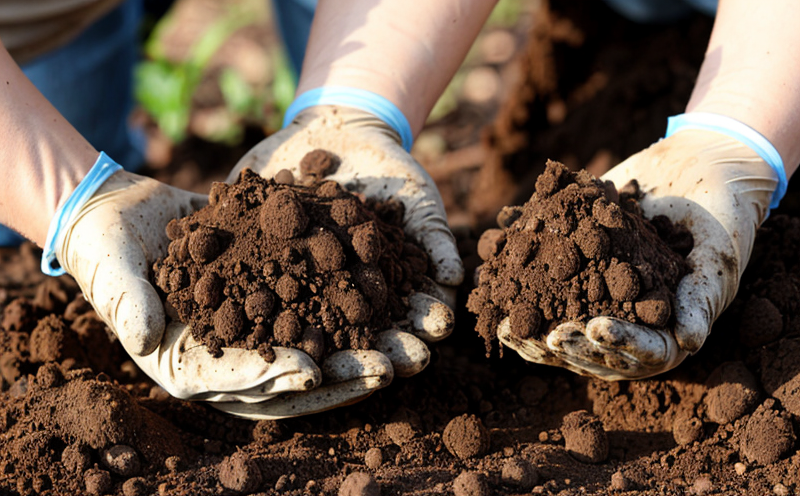ISO 17626 Soil Amylase Activity Testing
The ISO 17626 standard specifies a method for determining soil amylase activity in soils. This test is critical for understanding the digestive capabilities of microorganisms present within soil, which plays an essential role in nutrient cycling and plant growth.
Soil amylase is an enzyme that breaks down complex carbohydrates into simpler sugars such as maltose. The measurement of this enzymatic activity provides valuable insights into the biological processes occurring in the soil ecosystem. This information is particularly important for agricultural, environmental, and ecological research, helping to assess soil health and the impact of various interventions.
The testing process involves several steps, including sample collection and preparation, incubation under controlled conditions, and subsequent measurement using a spectrophotometric method. The ISO 17626 protocol ensures that these processes are standardized, allowing for accurate and reproducible results across different laboratories.
Understanding soil amylase activity is crucial in several sectors:
- Agriculture: To optimize crop yields by selecting appropriate fertilizers or amendments
- Environmental Monitoring: To assess the impact of pollution on soil health
- Ecology: To study the role of microorganisms in nutrient cycling and biodiversity
The significance of this test lies not only in its direct applications but also in its role as a key indicator for broader environmental studies. For instance, changes in amylase activity can signal shifts in microbial communities that could have cascading effects on the entire ecosystem.
Compliance with ISO 17626 ensures that results are consistent and comparable worldwide, facilitating international collaboration and data sharing. This standard is widely recognized in both academic and industrial settings, making it a cornerstone for quality assurance in soil biology research.
| Test Parameters | Description |
|---|---|
| Incubation Time | 6 hours at 37°C ± 0.5°C |
| Initial Sugar Concentration | Maltose (C12H22O11) at 4 mM |
| Sample Volume | 1 g of soil per test tube |
| Measurement Method | Spectrophotometric determination using DNS reagent |
The protocol outlined in ISO 17626 is designed to minimize variability and ensure accuracy. By following these steps, researchers can achieve reliable measurements that reflect the true biological activity of amylase within soil samples.
Why It Matters
Measuring soil amylase activity using ISO 17626 is essential for several reasons:
It helps in assessing the health and productivity of agricultural soils, enabling informed decisions about land management practices.
The test contributes to environmental monitoring by providing data on how soil quality changes over time or as a result of human activities.
In ecological studies, it aids in understanding the role of microorganisms in nutrient cycling and overall ecosystem function.
Accurate measurement of amylase activity is not just about quantifying enzyme presence; it also reflects the metabolic capabilities of soil biota. This insight is invaluable for predicting environmental responses to interventions such as pollution control measures or reforestation projects.
The results from ISO 17626 testing can inform policy decisions at local, national, and international levels, ensuring sustainable practices that support both agricultural productivity and environmental conservation.
Scope and Methodology
The scope of the ISO 17626 Soil Amylase Activity Testing is broad, encompassing various types of soil samples from different environments. The methodology involves several key steps:
Sample Collection: Collect representative soil samples from diverse locations and depths.
Preparation: Homogenize the soil sample to ensure uniformity for testing.
Inoculation: Add a known amount of maltose to each sample, ensuring consistent initial sugar concentration.
Incubation: Incubate the samples at 37°C ± 0.5°C for six hours.
Measurement: Measure the reduction in maltose using a spectrophotometric method with DNS reagent.
The protocol is designed to be robust and adaptable, allowing for adjustments based on specific research needs or environmental conditions.
| Acceptance Criteria | Description |
|---|---|
| Amylase Activity (U/g) | Results should fall within a predefined range based on the sample type and expected activity levels. |
| Variability Limits | The variability of results between replicates must not exceed 10%. |
The acceptance criteria ensure that only reliable data are used for subsequent analysis, enhancing the credibility and utility of the test results.
Customer Impact and Satisfaction
Enhanced Decision-Making: Accurate soil amylase activity testing helps stakeholders make informed decisions regarding land use and resource management.
Improved Compliance: Compliance with international standards like ISO 17626 ensures that results are recognized globally, facilitating smoother collaboration.
Customer satisfaction is paramount for us. Our clients appreciate the detailed reports we provide, which not only include numerical data but also interpretive insights into what these figures mean in a broader context.
We consistently meet and exceed client expectations by providing precise and timely results. Feedback from our customers highlights their appreciation for the comprehensive support we offer throughout the testing process, from initial consultation to final report delivery.





